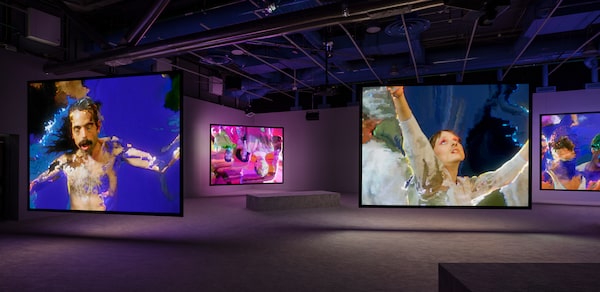
Phase Shifting Index, Jeremy Shaw's digital installation, was originally commissioned for the Pompidou Centre in Paris in 2020.Timo Ohler/Supplied
Artist Jeremy Shaw, a Vancouver native who lives in Berlin, has a long interest in parallel realities. Phase Shifting Index, his most ambitious film installation to date, features seven video channels, each one showing a pseudodocumentary about a group seeking trance or transcendence through choreographed movements. Shot using dated technology, such as Hi8 video, to achieve a retro look, some of the films are set in the past – check out those tacky 1980s costumes – and some are set in the future. Meanwhile, the language is often garbled as though people were speaking some new English dialect.
All the videos culminate in a remarkable digital crescendo, as the participants’ increasingly frenetic movements seem to take them to their goal. To say more would require a spoiler alert, but the result is an immersive installation where the audience might feel the same transport as that depicted on screen. Originally created for the Pompidou Centre in Paris in 2020, the work has toured extensively and is now showing at the Polygon Gallery in North Vancouver.
How did you first became interested in the theme of transcendence or seeking an alternate reality?
It probably evolved out of being raised Catholic, growing up with this ritual, this notion of some type of salvation, faith that leads you somewhere. That was instilled in me at a very young age. I really enjoyed the ritualistic aspect, the ceremony and the gathering, the communal elements. And that turned as a teenager into becoming involved in subcultures and experimenting with psychedelic drugs. And that grew into a much broader interest in this almost universal, age-old notion of humanity attempting to somehow escape the present, whether that’s through religion or through drugs or through meditation or dance. It’s really grown into this large survey of belief and faith – and science, the scientific areas that are attempting to map, translate and quantify these experiences.
Does it remain a personal activity for you as well as an intellectual or artistic interest?
Yeah. I’m into both affect and analysis. I’m certainly not religious but I still participate in this quest for catharsis or some type of transcendental behaviour. I meditate, I have a transcendental meditation practice. I’ve certainly toned down, from when I was younger, this aggressive attempt to somehow find God. But I think you can feel in the work that I’ve also been on the other side of the lens. That’s something I aspire to, to create a resonance that achieves an impact on the viewer that may be similar to what you’re watching on the screen.

Jeremy ShawAlex De Brabent/Supplied
The seven different practices portrayed, are they wholly fictional? They look a bit familiar.
They’re alchemical. There’s definitely elements pulled from subcultures, somatic and other types of movement based-practices and ideologies, but I’m not tracking a real subculture.
There’s one that uses a lot of a somatic practice called BMC [Body Mind Centering]. And one of the women in that film was leading the group through an actual BMC workshop.
It is choreographed. We workshop them similar to an actual workshop and then shoot them like a documentary. So there’s tons of intuition and chance that happens within the shooting process.
I found the combination of the pseudodocumentary tone and some of the retro clothing felt satirical. What is your intention there?
I think humour and comedy are there. But I don’t think it’s negative in tone by any means. I think that it’s quite playful and weird.
What do you mean by satirical?
Well, I thought the characters were deluded in their quest, they looked silly in their movements. But then in the end they achieve transcendence, so it’s optimistic.
I think you are right; there’s elements of that. There’s a satirical critical element definitely in dealing with all states of wellness. This revival of these themes in the culture has very quickly gone from a really positive thing into a capitalistic one.
Why do you use older technology to film it?
I had trouble with high-definition video, somehow when the cameras started getting really, really high end, it was almost too real for me. There was too much information. And so I started using cameras from my youth and going back to these outmoded media. I found it’s disarming to the viewer. When you’re working with these outmoded media, the viewer expects to be familiar with the material: You don’t expect to be surprised, you feel like it’s happened. There is this type of cognitive dissonance with showing someone something that looks authentically old, but then telling them it’s in the future and scrambling the language. It became a really visceral place to work from.
What are you working on next?
Since around 2016, I’ve been working on these moving image works really exclusively and it’s taken a lot of time out of my studio practice and that wasn’t something I ever intended, being a filmmaker. So, at the moment, I’m really back in the studio working on objects, trying to manifest similar concepts. Film and video have become how I think naturally and I’m excited to get back to a different way of thinking.
Phase Shifting Index is showing at the Polygon Gallery in North Vancouver to Sept. 24 and will visit the Musee d’art contemporain in Montreal from Dec. 12 to Feb. 25.
This interview has been edited and condensed.